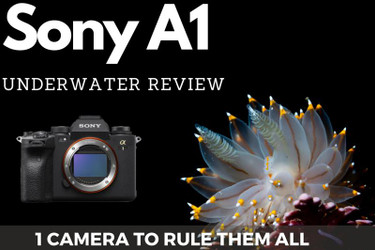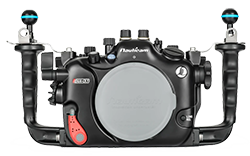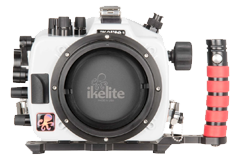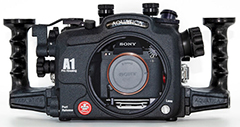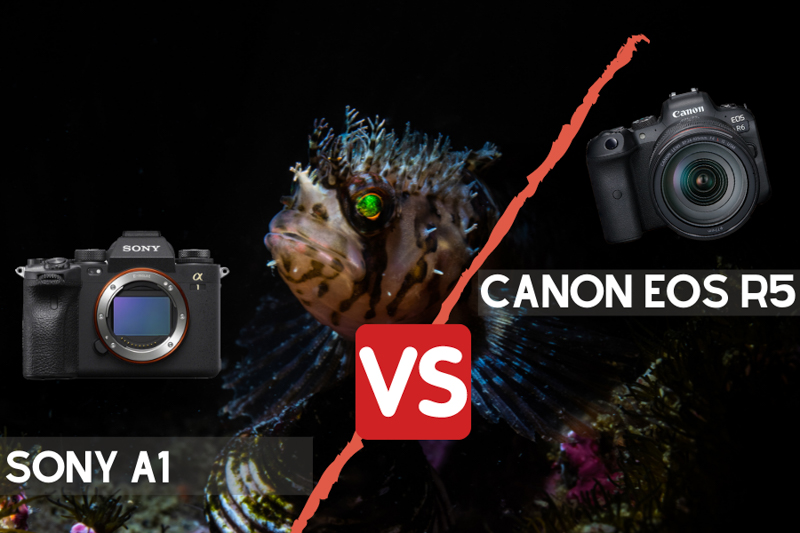Sony A1 Underwater Review
May 19th, 2021
Sony A1: One Camera to Rule them All
If money is no object, then there is no arguing that the Sony A1 is the best full-frame camera for underwater photo and video. As Sony's flagship, the A1 is the camera that the tech giant has deemed "worthy" of the first integer. It is a masterful showcase of the crème de la crème in imaging technology from a company that consistently leads the pack in innovation. And the specs sheet is not just eye-catching - it's novel. The Sony A1 boasts a new 50 megapixel stacked CMOS sensor that can shoot in 30 fps bursts with the electronic shutter as well as 8K/30p & 4K/120p video recording. Most notably, the camera's sensor features the unique ability to sync with underwater strobes using the electronic shutter - unlocking the capability of shooting 30 fps bursts with fast strobes like the Sea & Sea YS-D3 and the Ikelite DS 161s. Moreover, the mechanical shutter has a max sync speed of 1/400 of a second - giving underwater photographers the capability of stopping down almost a stop further in scenes with high dynamic range and freezing action.
But we can talk specs all day. What's more important is that we at Bluewater Photo & Video have dived extensively with the A1 underwater and can confirm that the Sony A1 can indeed do everything Sony says it can do. We were blown away by both the quality of the 50 megapixel photos and the details in the 8K video. But is the Sony A1 worth the hefty $6500 price for the body, especially when compared to the Canon R5? It's hard to say. However, there is also a surprising upside to the price of this camera, if you are an underwater creative. Both underwater housings for the Sony A1 that are currently on the market are compatible with the A1 and the Sony A7S III - Sony's top camera for underwater video. This means that you can have the best photo camera and the best video camera from Sony, there's no need to purchase a separate housing. It makes very good economical sense to buy both bodies, one housing, two strobes, and some video lights and you're set up with the ultimate Sony system! Ultimately, we hope the sample underwater photos and video in this review will help you decide for yourself if the Sony A1 is indeed, 1 camera to rule them all (LOTR pun intended).
Status: Shipping Now - Order Your Body Now at Bluewater!
U.S. MSRP: $6,500
Have you just purchased a Sony A1 from us? Check out our Sony A1 Underwater Settings Guide!
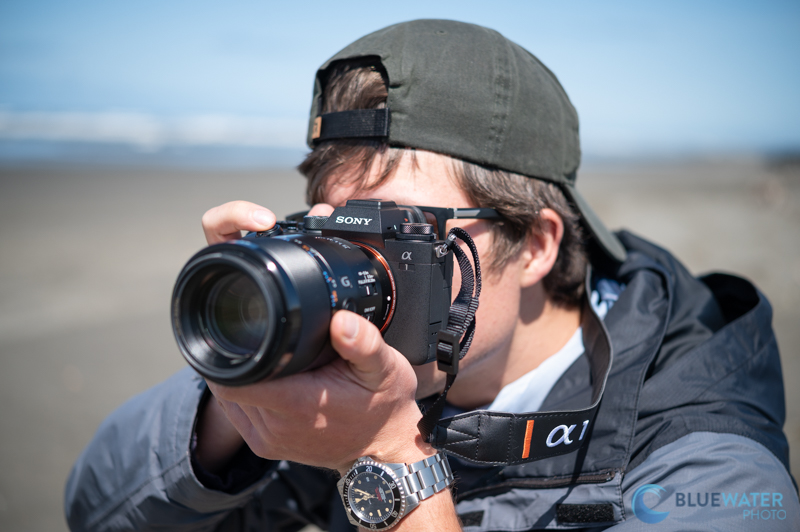
Sony A1
Order a Sony A1 underwater housing at Bluewater Photo:
Nauticam Sony A1Underwater Housing
Ikelite Sony A1 Underwater Housing
Sea & Sea Sony A1 Underwater Housing
Aquatica Sony A1 Underwater Housing
Isotta Sony A1 Underwater Housing
Marelux Sony A1 Underwater Housing
Order a Sony A1 Camera Body at Bluewater Photo:
Check out our Sony A1 Underwater Settings Guide
Check out our full Sony A1 Underwater Housing Buyer's Guide
Jump to a Section
Sony A1 Specifications | Sony A1 Features | Sony A1 for Underwater Photo
Sony A1 for Underwater Video | Best Lenses | Sony A1 Underwater Housings
Sony A1 vs Canon EOS R5 and Other Cameras | Conclusion
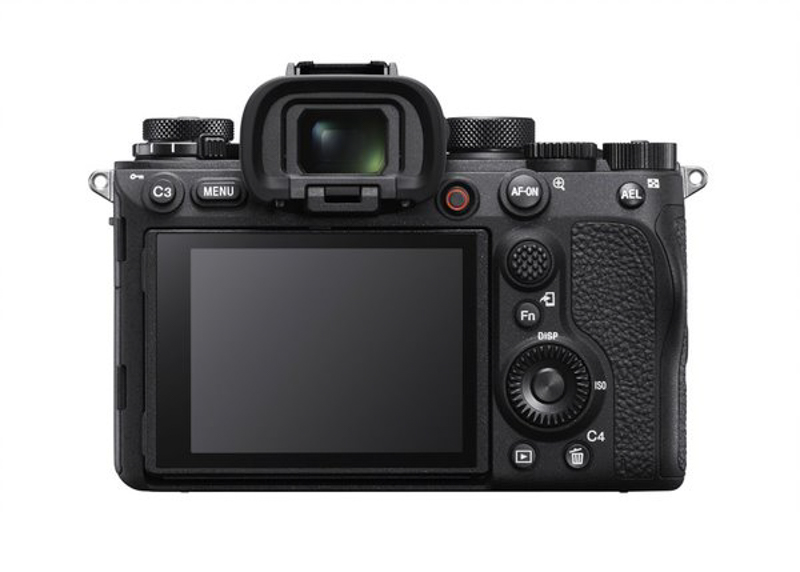
Sony A1 Specifications
- New Full-Frame 50MP Exmor RS Stacked CMOS Sensor
- 15 stops of dynamic range with improved colors, tones, and gradation
- New BIONZ XR Processor
- Continuous shooting up to 30fps w/ electronic shutter and 10fps w/mechanical shutter at full resolution - AE and AF operable throughout
- Updated Carbon-Fiber Mechanical Shutter for a more quiet and vibration-free performance
- Records video up to 8K/30p (oversampled from 8.6K), 4K/120p (oversampled)
- Improved electronic shutter - greatly reduced rolling shutter and flicker under artificial light
- THE ELECTRONIC SHUTTER WORKS WITH EXTERNAL FLASHES (and strobes, with a TTL converter)
- FLASH SYNC SPEEDS: up to 1/400sec (mechanical shutter; 1/500 in APS-C mode), 1/200 (electronic)
- Lightning-quick AF with its 759 phase-detection points with 425 contrast-detection areas - covering 92% of the sensor
- AF system recalculates 120 times per second - 30% more accurate than A9II
- Better animal eye AF that can track birds - does not track fish
- 5 axis IBIS with 5.5 stops of recovery
- 10-bit 4:2:2 internal recording with 16-bit RAW external recording
- Full range of Log recording options - Cine, HLG, and S-Log
- Viewfinder: Electronic (OLED) - 9.44 million dots
- Dual CFexpress Type A / UHS-II SD Card
- No built-in flash
- Native ISO: 100 - 32,000
- Extended ISO: 50 - 102,400
- Shutter speed: 1/8000 - 30 seconds
- ISO 100 to 32000 (Extended: 50 to 102400)
- Fastest built-in wifi - can transmit video files over 5G
- Sony E Mount
- Dimensions: 5.07 x 3.81 x 2.74 in (128.9 x 96.9 x 69.7 mm)
- Weight: 1.6 lb (737g)
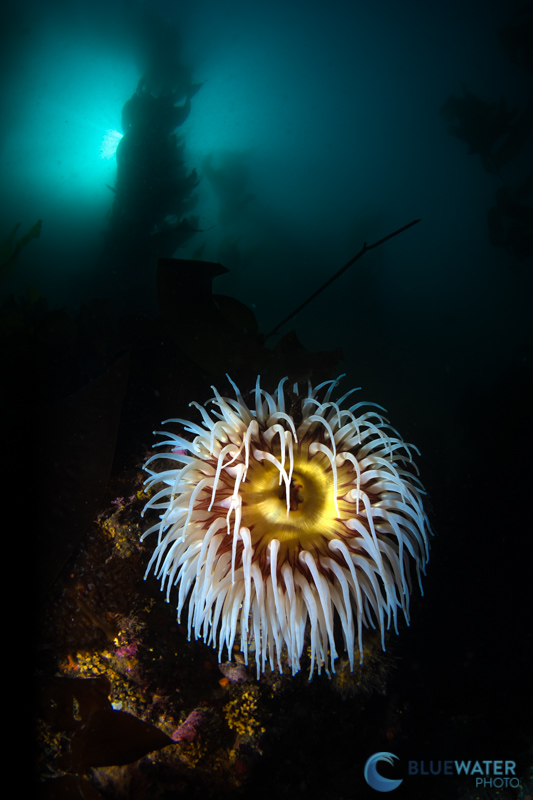
A beautiful kelp forest scene photographed with the Sony A1 in an Ikelite housing with the Canon 8-15mm fisheye lens. f/16, 1/400, ISO 100. This photo was only possible with the high 1/400 sync speed that the A1 is capable of.
Key Sony A1 Features
Build, Menus, EVF, Battery Life, and Ergonomics
It's truly incredible how small the Sony A1's form factor is for all that it can accomplish. The sheer processing power it takes to capture 8K video should be enough to make most cameras bloat to the size of a cinema camera. But the A1 is the same size as Sony's other full frame cameras including the A7S III and A9II. Like other Sony cameras, the A1 has a very solid, weather-sealed build, a crisp, high resolution EVF (electronic viewfinder), and a wide range of custom buttons (C1-C4). The Sony A1's EVF is the highest resolution viewfinder currently available which means it is much easier to see subjects in lighting situations with high dynamic range. This is a particular pain point for mirrorless cameras vs DSLRs, and it's nice to see such a capable viewfinder on a mirrorless camera. As with other mirrorless cameras, it was really nice to be able to review images and settings underwater through the EVF.
Beyond the solid build, most Sony cameras perform poorly when it comes to their ergonomics due to the convoluted menu system. But with the A7S III, Sony overhauled the menu system. So for the first time in a Sony camera, we can confidently say that the ergonomics on the Sony A1 are the best on the market! We absolutely love the new RGB, vertical menu system. It's very easy to navigate underwater and works quite nicely with the control layout on the camera. The customizability and options on the A1 are second to none. The works flow is incredible - it's just plain easy to shoot underwater. For example, at one point I realized I needed to custom set a button on a dive with very high current. While kicking hard, I was able to quickly flip through the menu, set what I needed to and go about my dive with the new setting. The number of customizable options can be daunting at first, so be sure to check out our Sony A1 underwater settings guide - complete with a settings video.
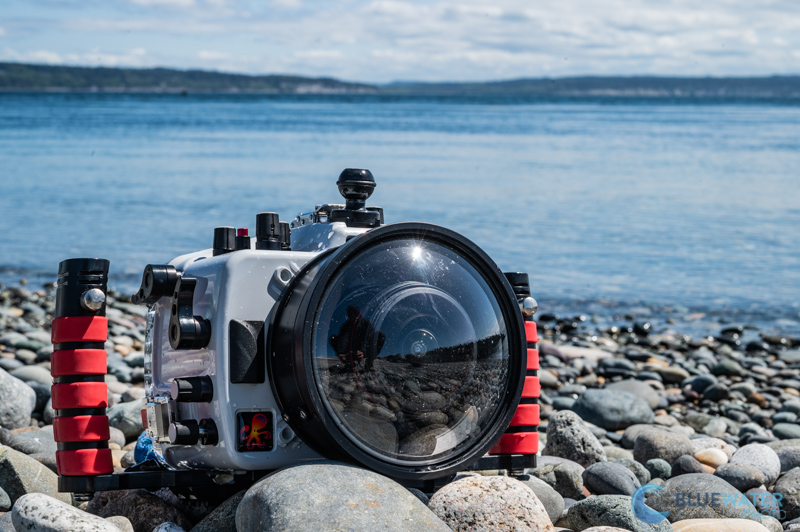
Sony A1 in an Ikelite Housing in the Field
Now to probably the most negative feature of the Sony A1 - the battery life is subpar....very subpar. We recommend changing the battery after about two dives. Granted we shoot a lot, but the paper rating of 530 shots just doesn't seem to hold up underwater. In fact, I did one dive that was an hour and a half, and my battery dropped all the way down to 23% from full. So bring extra batteries and be prepared to change batteries between dives.
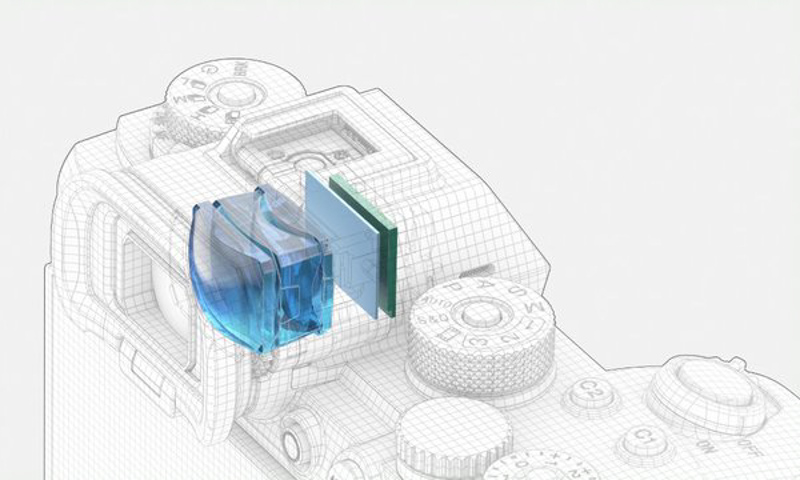
High Resolution EVF
Bugs and Quirkiness
This is not a section we've often had to put in an underwater camera review. But seeing as the A1 is Sony's flagship camera, we would like to be difficult in our grading. Unfortunately, we noticed a couple of bugs while we were shooting underwater. The first is a bug we've witnessed in Sony cameras from time to time. Despite the price point, every now and then the Sony A1 freezes. C'mon Sony! It wasn't often, but when we were changing settings quickly it happed about 2-3 times in a week of diving and then stopped after a few seconds. The second bug was a little more concerning and we hope that Sony fixes it in the next firmware update. Sometimes, we could not get the focus peaking to display in manual focus. It did not seem to have a pattern, it just didn't engage work at times when switching to manual focus.
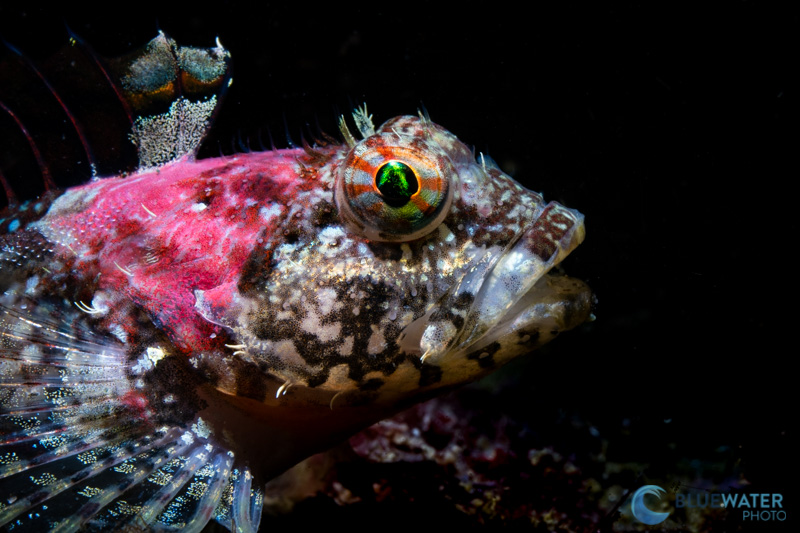
Sculpin photographed with the Sony A1, Sony 90mm macro lens, Ikelite A1/A7SIII housing. f/22, 1/200, ISO 320
There are a few controls with the Sony A1 that can be a little quirky, and we wanted to briefly note them. The drive dial and the autofocus mode dial on the left side of the camera cannot be changed internally in the camera - though the option is offered in custom settings. If you try to use it, the camera tells you to use the dials. Unfortunately, not all housings have compatibility with the autofocus mode dial, so you will have to change it above water with these housings.
Image Quality
Sony's new 50 megapixel dual stacked CMOS sensor on the A1 delivers. Right off the bat, we noticed that the color rendering in the files has indeed been improved as Sony claimed it would be - especially with tones and gradations. It's a common remark that the green/magenta spectrum is slightly off in many Sony cameras (or more true to nature depending on who you ask). We have noticed this as well, and have seen an improvement to this effect with the A1 - particularly in regards to video. Softer tones really seem to have improved with the new Sony A1 files. However, the underwater files can still be a little more difficult to edit than Canon or Nikon files.
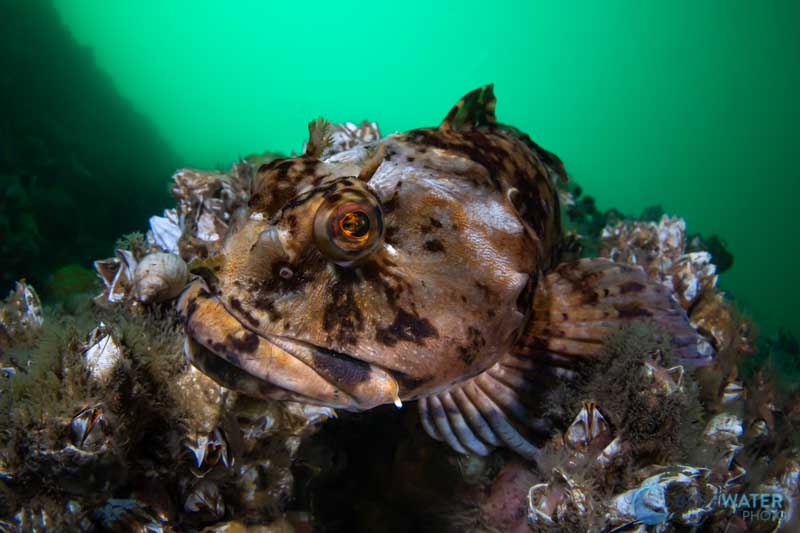
Cabezon photographed with the Sony A1, Canon 8-15mm fisheye & metabones adapter, Ikelite A1/A7SIII housing. f/13, 1/80, ISO 640
The most important feature of the new sensor is the excellent low light performance despite the higher resolution sensor. The Sony A7R IV has a slight problem with noise levels at higher ISOs. The Sony A1 knocks the A7R IV out of the part. We were able to shoot at ISOs up to 1250 in our photos without seeing noticeable degradation. Throughout the review, we consistently shot in dark, limited visibility shooting environments, and though our ISO was set to a minimum of 500, we almost never touched the luminance tool in lightroom.
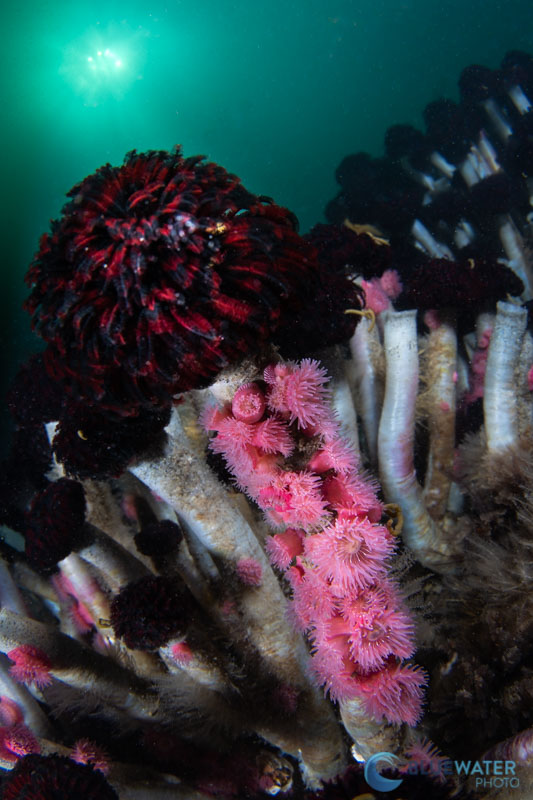
This photo shows the excellent wide dynamic range the A1 is capable of capturing at 1/400s. A tubeworm photographed with the Sony A1, Canon 8-15mm fisheye & metabones adapter, Ikelite A1/A7SIII housing. f/13, 1/400, ISO 100
Sony lists the A1's dynamic range performance as 15 stops on paper. For whatever reason, this was easier to see in our video than photos. Though the A1 performed well when we shot sunburst photos, it was difficult at times to get nice sun rays and a good gradient from the highlights to the shallows. Some photos even resulted in a bit of a "halo" effect though they were exposed properly. But we're being picky. The fact that you can shoot at a sync speed of 1/400th of a second, means that there is a lot more leeway in the highlights when you should sunbursts. We noticed overall that there is a ton of detail in the shadows that can be recovered, but the A1 seems to have a harder time with highlights. That being said, it's clear that the A1 handles dynamic range much better than the A7R IV.
Finally, we were curious to see if our electronic shutter photos would suffer image quality degradation in any way, but they did not. It was nearly impossible to tell the difference between a photo captured with the electronic shutter and one captured with the mechanical shutter.
5 Axis In-Body Image-Stabilization (IBIS) and Steady Shot Modes
The 5 axis in-body image-stabilization (IBIS) on the Sony A1 is on par with other Sony cameras. We didn't notice a real difference between the stabilization on the A1 vs the A7R IV. Unfortunately, the Sony A1 does not have "active steady shot" that was debuted on the A7S III. Though the A1s IBIS certainly helped us shoot better handheld video and low shutter speed photos, the Canon EOS R5 and R6 have much better IBIS performance.
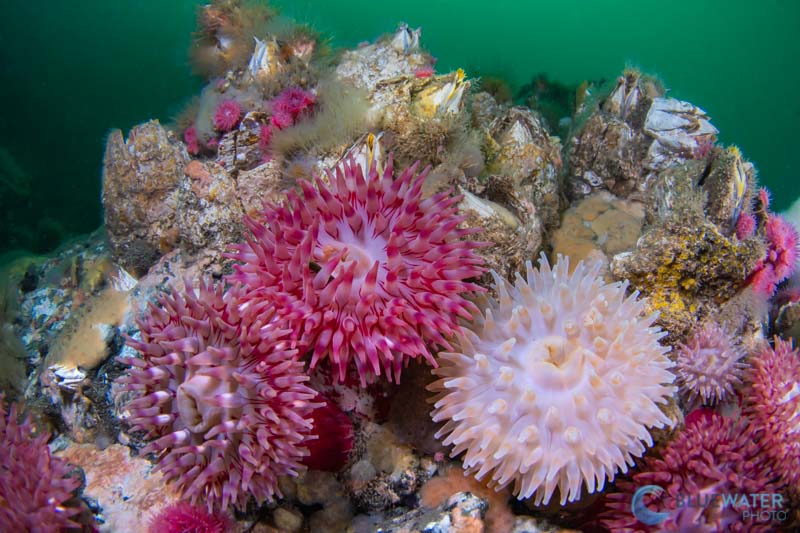
The Sony A1's IBIS allowed us to shoot at 1/60 in a high current situation. Anemones photographed with the Sony A1 in an Ikelite housing with the Canon 8-15mm fisheye lens. f/13, 1/60, ISO 400
Autofocus System
From the perspective of speed and accuracy, the Sony A1 has the world's best autofocus system. It's blazing fast. In fact, it is 30% more accurate than the A9II, which already had the world's best autofocus. The autofocus engine recalculates an astonishing 120 times per second. We noticed that the autofocus tracking system was even stickier to the subject than previous Sony cameras like the A7R IV! Due to the accuracy of AF tracking, we kept the camera in this mode for most of the review. This allowed us to pan and recompose while the AF point stuck to the subject. The acquisition speed is also very quick in AF single with each one of the area modes. In the wide AF area mode, the A1 did a particularly great job of choosing the right subject to focus on. Normally, I don't allow the camera to choose the focus point, but there were some situations where I got lazy and let the A1 do it for me.... to great success.
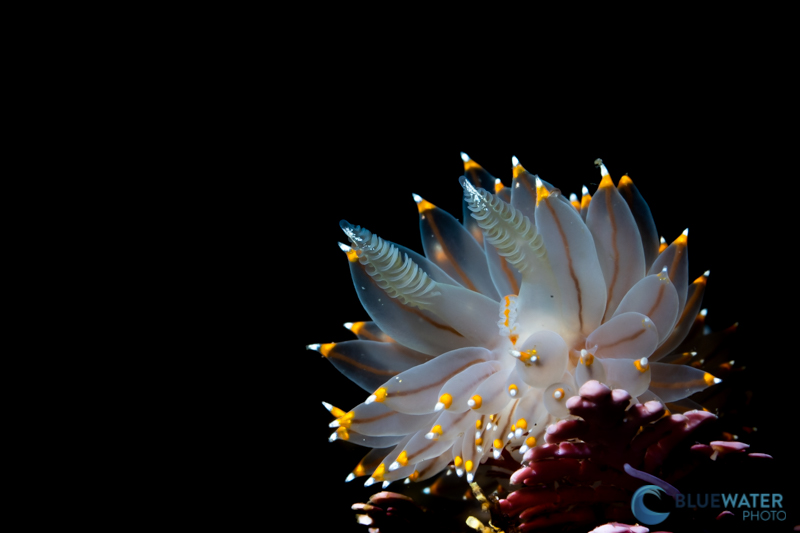
Autofocus tracking on the A1 resulted in sharp rhinophores on this nudi. Janolus nudibranch photographed with the Sony A1, 90mm macro lens, Ikelite A1/A7S III housing. f/22, 1/200, ISO 200
The autofocus tracking overall is just slightly better than the Canon EOS R5. That being said, the animal eye autofocus tracking works moderately well in the R5 and does not seem to work at all on the Sony A1. We tried to use the animal eye AF system in "bird mode" and "animal mode" (dogs and cats), and it never picked up a fish. However, we are optimistic that Sony will debut a system that works with fish to keep up with the Canon EOS R5.
When we tested the A1 with the Canon 8-15mm fisheye and the metabones adapter, the autofocus speed slowed down quite a bit. We recommend using single autofocus with a metabones or Sigma MC-11 adapter and the A1. But if you are using a Sony lens with the A1, the autofocus is so fast and accurate that you can leave it in autofocus continuous mode.
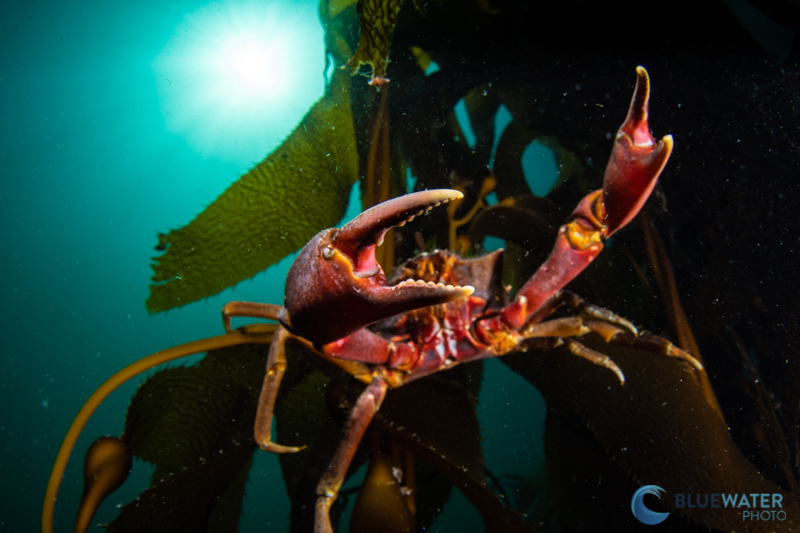
Kelp crab photographed with the Sony A1, Canon 8-15mm fisheye & metabones adapter, Ikelite A1/A7S III housing. f/16, 1/400, ISO 100
During our review, we were very excited to see just how many "keeper" shots we got from our dives. More often than not, a bad photo was not due to focus but due to lighting. But don't take our word for it. Check out the video below to see exactly how the autofocus performs in the Sony A1:
New Shutter, Sync, and Burst Shooting Technology
For underwater photographers and video shooters, Sony's engineering of the A1's sensor and shutter has resulted in a new door opening to creative expression. Although this new electronic shutter might not be a global shutter, it is the next best thing with an ultrafast readout powered by the BIONZ XR processor. The fast readout of the silent electronic shutter now allows for the electronic shutter to sync with external flashes like strobes! This means underwater photographers are able to shoot silently underwater, other than the noise their strobes make - up to the rated 30 fps burst speed synced with strobes. In many cases, strobes can't keep up with burst speeds that quick, but some strobes can get close at low power - particularly the Sea & Sea YS-D3s and the Ikelite DS-161s. What's incredible is that at even 30fps, autofocus and autoexposure still works on the A1.
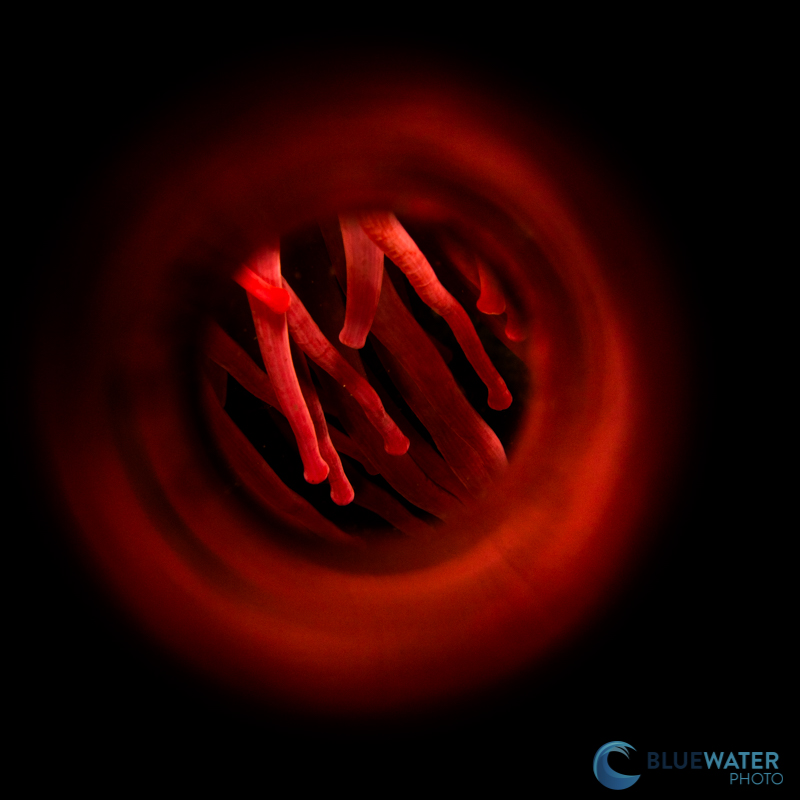
This photo was captured with the electronic shutter. Anemone tentacles photographed with the Sony A1, 90mm macro lens, Saga magic tube, Ikelite A1/A7S III housing. f/22, 1/200, ISO 200
Now there is a caveat. To use the electronic shutter with strobes, you will need to use a TTL converter that "tricks" the camera into believing the strobe is a Sony brand flash. We will be following up with a list of TTL converter/strobe combination compatibility. Currently, we do know that Ikelite strobes combined with the Ikelite TTL converter work with the electronic shutter in the camera. It was just incredible how fast that combination could shoot underwater at low power. Albeit, the strobes did miss a couple of frames, but it did an amazing job overall and we highly recommend this combination to photographers that want to take advantage of the burst capability. Ikelite strobes and TTL converters can be adapted to Nauticam/Isotta housings as well, so if you are interested in this option, please contact us at sales@bluewaterphotostore.com and we will find the right combination of strobe, housing, and TTL converter for your needs.
The mechanical shutter has also been updated on the Sony A1 with carbon fiber for better vibration and sound reduction. It is now capable of syncing with underwater strobes at an amazingly quick 1/400sec. Most modern cameras are only capable of a sync speed of 1/250, which means you can stop down by an extra stop if you need to. We enjoyed the extra leeway it gave us shooting underwater sunballs and were pleased with the details in the highlights we were able to capture. We also found a 1/400 sync speed helped with acquiring black backgrounds in macro photos and freezing quick subjects in high current. We should not that our strobes (both the Ikelite DS 161s and the Sea & Sea YS-D2Js) did not quite sync at 1/400 at times. Some images depicted a small black bar. To be safe, it is better to shoot at 1/320 for the perfect sync, but in most cases, 1/400s will work very well. The electronic shutter sync speed is 1/200.
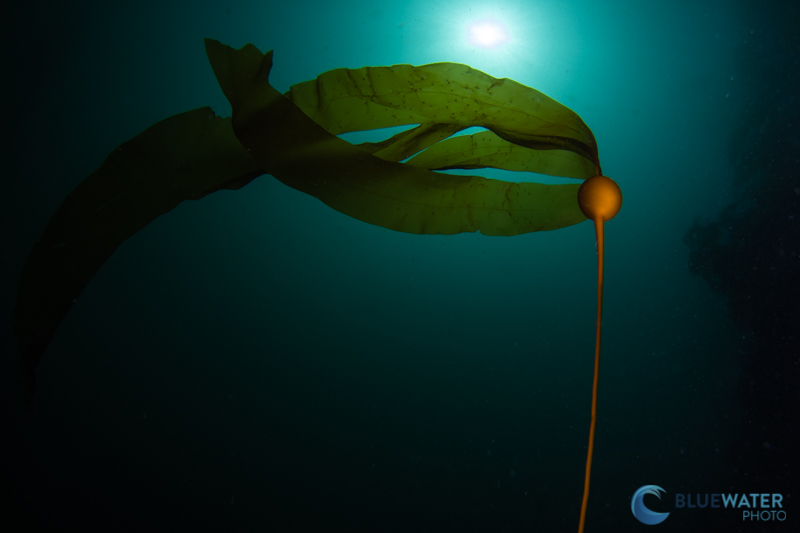
This photo was captured with a 1/320 sync speed which ensures a proper sync with strobes. Bull kelp photographed with the Sony A1, Canon 8-15mm fisheye & metabones adapter, Ikelite A1/A7S III housing. f/16, 1/320, ISO 64
Sony A1 for Underwater Photo
On paper and in practice the Sony A1 is the best camera on the market for underwater photography. The new dual stacked 50MP sensor results in Sony's best high resolution image quality with accurate color rending and low noise at higher ISOs. It's a significant improvement from the Sony A7R IV and is a better choice for photographers looking for a high resolution sensor. And though the upgrade to the Sony A1's autofocus system is only slightly noticeable, that is only because the AF system on the A1 is pretty close to perfect (except for the animal eye AF tracking). When you factor in 30fps burst shooting synced with strobes and a sync speed of 1/400s, there really is no comparing the A1 to any other on the market...except when it comes to price. The Canon R5 is really close in performance to the A1. And ultimately, the difference in price comes down to the 1/400 sync speed on the camera and the electronic shutter sync with strobes. If this is something you absolutely need, then for $2600 more, the Sony A1 is the camera for you. We think the Sony A1 is an underwater camera for those who don't mind paying a premium for the frontier of camera technology and for those that very specifically need extremely quick burst shooting speeds in low light conditions (where strobes can keep up). The A1 is also the ideal camera for photographers that shoot with strobes in very shallow, low light that can benefit from extremely fast sync speeds.

Reef scene photographed with the Sony A1, Canon 8-15mm fisheye & metabones adapter, Ikelite A1/A7S III housing. f/13, 1/100, ISO 640
Overall, we think the photos that we captured prove the Sony A1 is Sony's best camera for underwater photography. We were particularly happy with the color rendering of some of the complex reefs and walls that we photographed on high-current dives. Some of the subjects we photographed were very quick - like mosshead warbonnets. The camera had no problem tracking them in low light with no focus light. Never once did we have to worry if our camera would keep up. When your camera performs as well as the Sony A1 did for us - underwater photography becomes a matter of composition and not "operation."
Sony A1 for Underwater Video
For underwater video, the Sony A1 is essentially a higher resolution Sony A7S III with 8K recording. Many of the original technology debuted in the A7S III has been cannibalized by the A1. However, we still think that the Sony A7S III is a better camera for two reasons - it has better stabilization, and cleaner video in low light. That being said, the 8K quality from the A1 is incredible. We loved shooting little cup corals and nudibranchs and cropping down to 4K to see the minute details of supermacro subjects. So if you like macro video shooting, you may seriously want to consider the Sony A1. The 4K/120p underwater video capability was also particularly useful for stabilization. As we mentioned, the A1 does not have active steady shot stabilization like the A7S III - which incorporated electronic stabilization with the A7S III's IBIS. Therefore, we found ourselves shooting 4K/120p more often with the A1. 4K/120p did result in extremely stable footage, but it can be a data hog and more difficult to process. Overall, it's the sheer number of video options that make the Sony A1 our new favorite camera for 8K video.
Sony A1 Underwater Video
Overheating Concerns
After a couple weeks of diving in cold, 45-50F water with the Sony A1, our camera never overheated on a dive. That being said, we did receive a temperature warning about 25 minutes into our third dive on one day of shooting. We have seen reports that the Sony A1 can overheat after shooting 8K/30p or 4K/120p video anywhere from 20 minutes to 80 minutes. It really depends on shooting conditions. We don't think most video shooters will experience this unless they plan on leaving the camera running throughout the dive at 8K. But this would also not be a good idea as 20 minutes of 8K footage is about 300GB!
Video Recording Options and File Types
One of the most compelling reasons to purchase the Sony A1 is the wide range of frame rates, bit rates, codecs, file types, and picture profiles for different video workflows.
Selecting Your 4K Codec
The file format, or codec, you choose will determine how much your video is compressed and the bit rates you can shoot at. An uncompressed codec will take up more space on your hard drive, but it will also be easier for your computer to process as it will have to do less work decoding. So the more compressed your video is, the more time you should plan on spending in post. The Sony A1 has a few different 4K codec options, so here are the three codecs available to you when shooting 4K:
1. XAVC HS 4K - This is the most compressed codec and we generally don't recommend using it unless you need to save a lot of space and want to spend more time in post processing. It uses an H.265 compression standard that some graphics cards may have trouble handling.
2. XAVC S 4K - This is Sony's standard file type, and the codec that will suit the widest range of needs. You will be able to shoot 120 fps with this file type and vary your bit rates quite a bit. We recommend this file type for most video shooters. It uses an H.264 compression standard that should be relatively easy to handle with standard editing softwares and graphics cards.
3. XAVC S-I 4K - Ths is the least compressed file type available. It will be easier to playback, but it will also create large file sizes. It features a bit rate of 600M 10bit 4:2:2 at 60fps - that's a lot of data!
When it comes to selecting your bit rate and color sampling - generally you want to select a higher bit rate and 10-bit 4:2:2 if you plan to color grade your video in post processing. If you do not plan on color grading and wish to shooting with the standard picture profile, then 8-bit 4:2:0 will save space in your files but give you less color options.
Recommended Video Recording Picture Profiles
Sony uses a variety of picture profiles to recover data and dynamic range from complicated scenes. These are some of our favorite picture profiles that we shoot with the Sony A1.
Standard (No Picture Profile) - We recommend the standard picture profile if you don't want to do much color grading or post processing. Sony's standard picture profile is quite nice, but you need to be accurate with your exposure and white balance when you shoot with the standard profile.
S-Log2 - S-Log2 offers the most detail out of the Log profiles with the least risk for introducing noise compared to other S-Log profiles. It is more difficult to edit than HLG or Cine profiles, but it can produce some of the best results. S-Log2 must be shot at a minimum of ISO 800. Try to use this profile in situations with a lot of light. We recommend overexposing your scene rather than underexposing.
S-Log3 - S-Log3 offers more detail in the shadows than S-Log2 but it can be more difficult to work with and introduce more noise as well. S-Log3 must be shot at a minimum of ISO 800. Try to use this profile in situations with a lot of light. We recommend overexposing your scene rather than underexposing.
HLG3 - HLG3 is our top recommended Log profile. It's easier to work with than S-Log2 and allows you to shoot at lower ISOs down to ISO 200.
Cine2 - Cine2 is a good hybrid between a Log profile and standard profile which makes it the easiest Log profile to work with in post. This is a good middle ground if you want to do some work in post but not a lot.
Best Underwater Lenses for the Sony A1
In recent years, Sony has gone from having a limited supply of lenses for underwater photography to one of the best repertoire of native lenses for full-frame mirrorless cameras on the market. Sony A1 users have an excellent set of choices for shooting macro, wide, mid-range, and fisheye.
Wide-Angle Lenses
The Sony 16-35mm F4 lens is the top wide-angle lens choice for photo and video. If you’re looking for something even wider to get nice close-focus wide-angle (CFWA) shots of reefs there are a couple of options for shooting fish-eye. The 28mm prime lens with a fisheye conversion lens will give the widest possible angle of view. The fisheye conversion lens can be used behind a large or small dome port, while the Sony 16-35 mm F4 lens is recommended for use with an 8-inch dome or larger.
Wet wide-angle lenses are a great option with this camera. We recommend the Nauticam wet wide-angle lens or the Kraken KRL-01 wet wide-angle lens with the 28mm prime lens. All of these options are very sharp and will result in stunning wide-angle photos.
Mid-Range Lenses
The Sony 24-70mm F 4 or the Sony 28-70mm F3.5-F5.6 are good choices along with the 35mm F2.8 portrait lens.
Macro Lenses
For underwater photography, the Sony 90mm macro prime lens is the best choice for small fish and macro subjects. It is exceptionally sharp and produces high quality images. A 50mm macro lens is another great option, though it doesn't focus as quickly as the Sony 90mm.
The Sigma 105mm f/2.8 DN DG Art macro lens is a new lens that we tested during this review. We highly recommend it for the Sony A71, though there is some focus breathing that video shooters should be aware of. Check out our full review of the Sigma 105mm here!
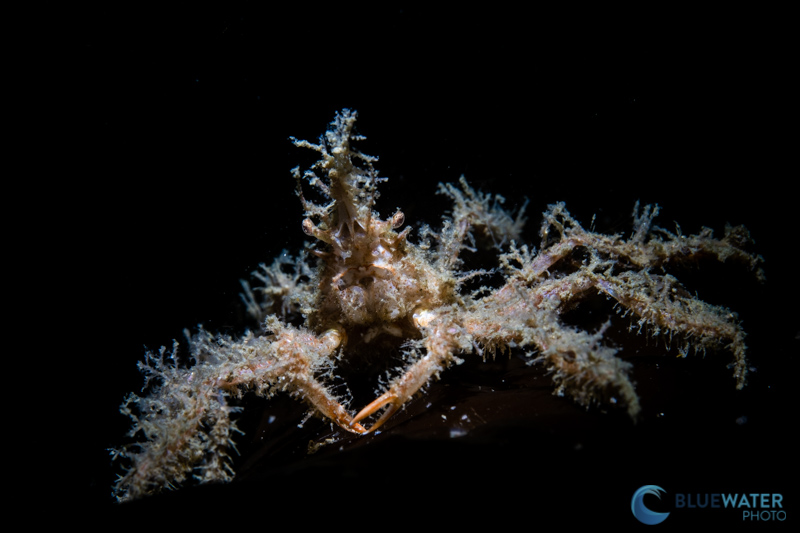
This photo was captured with the Sony 90mm macro lens and the Sony A1. 1/200, f/16, ISO 320
Recommended Topside Sony Lenses
While we love to dive with Sony lenses, they perform to the same high standard on dry land too. If you're considering adding to your topside kit bag, look through the options below.
Telephoto
- Sony 600mm F4 FE GM OSS - Ideal for capturing fast-moving subjects from a distance. This top-of-the-line telephoto lens is everything you'd expect from a flagship product.
- Sony 200-600mm F5.6-6.3 FE GM OSS - The 200-600mm focal range is very versatile and can be used in a variety of situations.
Wide-Angle
- Sony 12-24mm F4 FE Wide-Angle - A high-quality wide-angle zoom that's perfect for landscapes, interiors and other times when the goal is to get as much in the frame as possible.
Canon Lenses
Canon lenses can be attached to the Sony A1 with the Metabones, Sigma MC-11, or Photodiox adapters, but auto-focus is generally better with Sony lenses. Lenses like the Canon 8-15mm, 16-35mm, and 17-40mm work well. You can also use the Canon 100mm macro lens.
We did our review with a Canon 8-15mm fisheye lens and a metabones adapter, behind the Ikelite 8 inch compact dome port for close focus wide angle. Unfortunately, we noticed that the autofocus with this setup is very slow. We only recommend using the Canon 8-15mm if you intend to shoot slow scenes or plan on shooting with manual focus.
Top Underwater Housings for the Sony A1
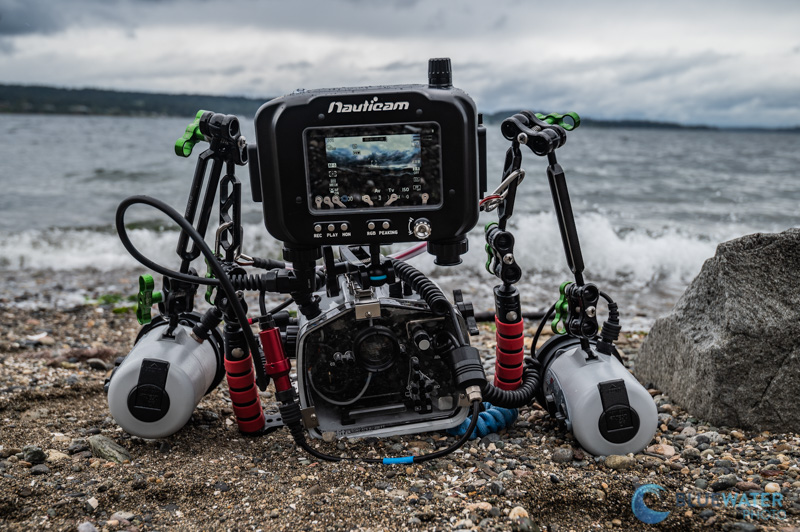
Our system in the field - an Ikelite Sony A1 housing with a Nauticam Atomos Ninja V Housing attached for live monitoring
Currently there are two very exciting underwater housings for the Sony A1 - the Ikelite Sony A1 housing and the Nauticam Sony A1 housing. Due to the anticipated popularity of the camera, we anticipate a model housing from all major housing manufacturers - including Sea & Sea, Aquatica, and Isotta. One of the most exciting features of the current Sony A1 housings available from Nauticam and Ikelite is that they are both compatible with the Sony A1 and the Sony A7S III. The Nauticam housing does require a conversion kit for the Sony A7S III. This cross compatibility is a very exciting opportunity for Sony shooters to shoot the two best cameras from Sony in the same underwater housing. Check out our full Sony A1 Housing Guide Here.
SONY A1 UNDERWATER HOUSINGS:
Nauticam Sony A1 Underwater Housing
*This Housing is Compatible with the Sony A1 and Sony A7S III Cameras (with a compatibility kit for the Sony A7S III)*
*Excellent Ergonomics, User-friendly, Durable*
The Nauticam Sony A1 Underwater Housing is built from aircraft grade aluminum which makes it durable and lightweight. It has full control over the Sony A1 camera including compatibility with the autofocus joystick, the drive mode dial, and the autofocus mode dial. The patented port locking mechanism makes it very easy to remove and add ports and Nauticam optics like the WACP-1 and WACP-2 - providing you with the option for the best rectilinear wide optics underwater.
ORDER NOW!
Ikelite Sony A1 Underwater Housing
*This Housing is Compatible with the Sony A1 and Sony A7S III Cameras*
*Affordable, Lightweight, Durable*
The Ikelite Sony A1 & Sony A7S III Underwater Housing is a top quality, corrosion free ABS-PC blend polycarbonate housing. It's sturdy and lightweight underwater. This housing offers professional ergonomics at an excellent price point. Most notably, the Ikelite A1 and A7S III housing is compatible with Ikelite's incredible TTL system. The back of the housing is clear so you can see everything going on inside of your camera, and it has a built in vacuum valve (pump sold separately) for additional safety. The dry lock port system is compatible with most Sony and Canon lenses adapted with a metabones adapter. We dived with an Ikelite Sony A1 and A7S III housing for both our Sony A1 and Sony A7S III review and loved using it! We put it through some of the highest current and surf we could find and it came out of our cold waters without a scratch.
ORDER NOW!
Aquatica Sony A1 Underwater Housing
*Rugged, Compact, Simple and Easy to Use*
The Aquatica Sony A1 Underwater Housing is made from anodized aluminum, The housing is durable, robust, rugged and can take a beating. It's controls are intelligently designed so that all important camera controls are within a fingers distance from the handle. In addition, Aquatica offers different bulkhead configurations to choose from.
ORDER NOW!
Marelux Sony A1 Underwater Housing
*Durable and Lightweight*
The Marelux Sony A1 underwater housing is built from high-grade aluminum alloy which provides durability and can withstand even the toughest beatings. Ergonomics are also top-notch, all camera controls are readily available at your fingertips and all buttons are clearly labeled. Thanks to its small size, it is great to travel with. Assembling the housing itself and installing a camera is a breeze with its quick release plate so you can spend more time under the water and less time setting up your gear. With a depth rating of 100m, this housing is an excellent option for both recreational divers as well as technical divers.
ORDER NOW!
Sony A1 vs the Canon EOS R5
Lets compare the two top contenders for underwater camera of the year - the Sony A1 and the Canon EOS R5. A quick look at a specs sheet would indicate that the Canon EOS R5 and the Sony A1 are very similar cameras with very different price points. But that's not the case. In fact, the R5 and A1 are very different cameras with different price points, you just need to dig deep to see it. So let's look at the pricing - the Canon EOS R5 is priced at $3900 whereas the Sony A1 is priced at $6500. The clear distinction is that Sony created the A1 to rival Canon's flagship, the Canon 1DX Mark III which is priced similarly - not the R5. This distinction physically manifests itself in the A1 with a wider range of video features, a slightly quicker (but not better) autofocus system, quicker burst shooting, and new electronic shutter technology.
But ultimately we think these differences are not enough to justify the price. The Canon R5 is still the better deal of a camera - particularly for photo and hybrid shooters. If you lean heavily towards shooting video, then you might want to give the Sony A1 another look due to the wider range of video options. Let's dissect this in more detail.
Underwater Video with the Sony A1 vs the Canon R5
Although Canon boasted early on about the video features on the Canon EOS R5, they do fall short compared to the A1 in most regards. The Sony A1 goes a step further than the R5 with its 8K video by oversampling 8.6K video with 15 stops of dynamic range. The A1 also has the full range of video features that carried over from the Sony A7S III including Cine, HLG, and S-Log picture profiles, active steady shot image stabilization, 4K/120p recording (oversampled), and 16-bit RAW recording to an external recorder. But it's important to note that although the A1 has a wide range of picture profiles and codec options compared to the R5, the Canon EOS R5 does not necessarily need them. The R5 is still currently the only full frame camera that can record RAW internally 8K and 4K/120p. So if you are considering the Sony A1 for it's video benefits over the Canon R5, you may also want to consider investing in an Atomos Ninja V system so that you can also record RAW video externally. Check out this article if you want some more information on why external recorders can be great for shooting underwater video.
Sony A1 Underwater Video
After shooting hours of underwater video with each system, we feel that the Sony A1 is a more capable camera in low light and has many more shooting options for seamless workflows in post processing. However, the Canon EOS R5 does have a far superior in-body image-stabilization system which results in much more stable handheld video. We struggled to shoot handheld video with the Sony A1 and the Sony 90mm macro lens without being in 4K/120p, but the Canon R5 was extremely stable with the Canon 100mm macro lens at 4K/60p. Because both cameras can shoot 4K/120p, slow motion footage can help stabilization quite a bit with either camera.
Canon R5 Underwater Video
And finally, lets talk about overheating. We have been hearing a myth that the Sony A1 does not overheat when filming in 4K/120p and 8K. Unfortunately that's not true. While on paper, it lasts for about an hour shooting 8K at room temperature in a controlled environment, we have seen reports of the A1 overheating from anywhere between 20 minutes to 80 minutes. The Canon EOS R5 might be known for overheating after about 30 minutes, but neither camera overheated to the point of shutting off in any of our coldwater dives in 45-50F water. We did get one temperature warning on the Sony A1 at 22 minutes into our third dive in a day of diving. But most video oriented shooter should find that their camera likely will not overheat unless they plan on shooting continuously in 8K or 4K/120p throughout the dive.
Autofocus with the Sony A1 vs the Canon R5
When it comes to autofocus, the Sony A1 and the Canon R5 are very, very similar. However, their AF systems do differ in important ways. The Sony A1's autofocus tracking and acquisition is dead-on sticky. We found it to be slightly quicker than the autofocus system in the Canon R5 underwater. But only slightly. On the other hand, the Canon EOS R5's animal eye autofocus tracking system is currently the only animal eye system that works somewhat reliably on fish. While we expect Sony to catch up soon, the A1s animal eye AF system does not work at all on fish. Overall, both cameras are so accurate, and we have had such a high "hit rate" with both systems that it would be hard to image better autofocus.
Image Quality with the Sony A1 vs the Canon R5
The image quality between the Sony A1 and the Canon R5 is somewhat subjective. Overall both sensors are excellent in low light and produce very little noise for being such high resolution sensors. Though the resolution on the Sony A1 is slightly more than the Canon R5, the difference is not discernable. We felt that the Canon R5 files were slightly easier to edit and color correct than the Sony A1, but again this is a rather subjective opinion. Both cameras perform well in high dynamic range situations. Because both cameras are so similar in their image quality, we think it's better to make your choice of camera based on lens selection. In this case, Canon does beat Sony slightly in terms of lens selection for underwater photography (particularly when it comes to fisheye lenses). The Canon 100mm macro is also a better lens than the Sony 90mm macro because you can stop a little farther down to get more details in supermacro photos.
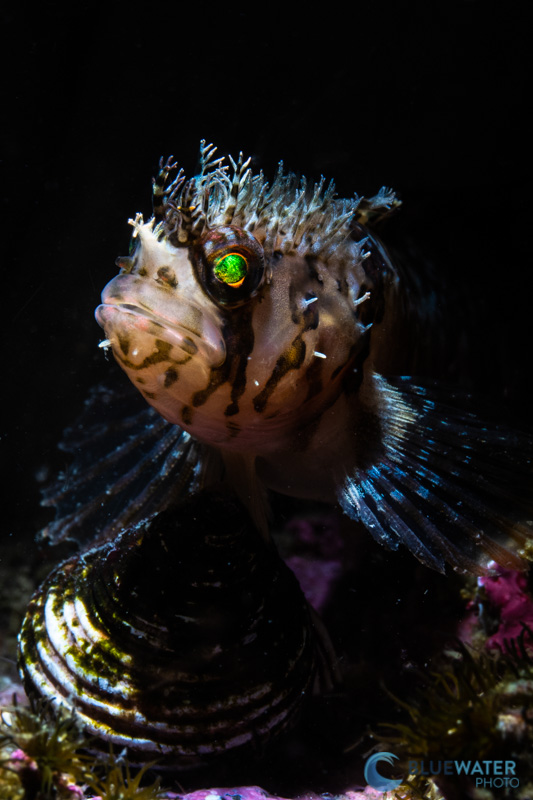
Mosshead Warbonnet Photographed with the Sony A1
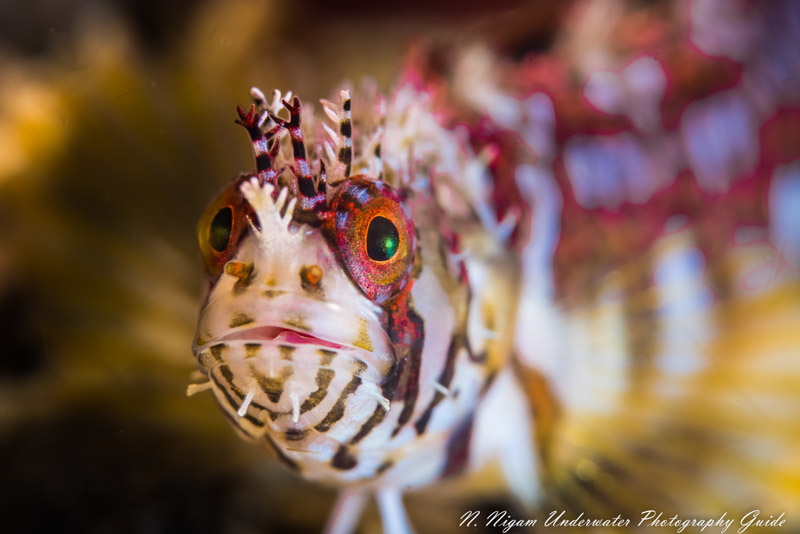
Mosshead Warbonnet Photographed with the Canon EOS R5
When the Canon EOS R5 is Clearly Better than the Sony A1
The Canon R5 has the Sony A1 clearly beat on lens selection (see above) and in-body image-stabilization system. We firmly believe that the IBIS system on the Canon R5 is much more capable than the Sony A1 - both on paper and in practice. On paper, the Canon EOS R5 can recover up to 8 stops with it's IBIS system. This means that you can shoot at shutter speeds 8 stops lower than what would normally cause motion blur. We effectively took underwater photos with the R5 at 1/8th of a second and below and captured beautiful green-blue backgrounds with crisp subjects. We were also able to shoot handheld video easily with a 100mm macro lens. While the A1 has a great IBIS system, it isn't Sony's best - that's reserved for the Sony A7S III which is equipped with the "active steadyshot mode".
Read our full Canon EOS R5 Underwater Review
When the Sony A1 is Clearly Better than the Canon R5
Where the Sony a1 really shines over the EOS R5 is an updated electronic shutter system powered by a new BIONZ XR processor. The A1 is the first camera to have flash sync compatibility with the electronic shutter as well as significantly reduced rolling shutter and flicker. When using a TTL converter which "unlocks" electronic shutter flash syncing, we found the system to be lightning quick while shooting 30fps burst photos. But most strobes can't keep up with these kinds of burst speeds. And when they can they'll miss a few frames, and you'll need to be in a low light setting so that the strobes can be at lower powers. To finish things off the Sony A1 can also sync with a strobe up to 1/400 sec! This means that you'll be able to freeze motion better with the A1 and recover highlights in sunburst photos by an additional stop.
The Sony A1 vs The Sony A7S III vs The Sony A7R IV
The Sony A1 may be Sony's flagship model, but the Sony A7S III and the Sony A7R IV still serve a special purpose for underwater photo and video shooters. The Sony A7S III is our favorite camera for underwater video in 2021. While the Sony A1, does cannibalize many of its picture profiles, codecs, and video features, it does not cannibalize the incredible low resolution sensor and pseudo-"dual-gain" capability of the A7S III. The lower resolution sensor/larger pixel size on the A7S III allows it to capture cleaner underwater video - especially in low light situations. So if you're shooting in limited visibility, we found that the A7S III captures really incredible footage that allows you to expand your shooting situations. But if you are a macro video shooter and want to crop your footage to 4K, you may want to consider the A1 which takes excellent 8K video. The Sony A7S III is limited to 4K shooting because of the lower resolution sensor. For the same reason, the A7S III is not a great photo camera. So if you aren't 100% video-oriented, you may want to consider the Sony A1.
Read our full Sony A7S III Underwater Review
The Sony A7R IV, on the other hand, is the world's highest resolution full frame camera. At 61 megapixels, the A7R IV can capture incredible details. But unless your conditions are perfect and your settings are accurate, it can often be difficult to see the improvements in resolution of the A7R IV over the A1 - which clocks in at 50 megapixels. The A7R IV also has some additional noise at higher ISOs due to the small size of each pixel on the sensor. This also produces more motion blur with the A7R IV, so it's important to shoot at slightly higher shutter speeds with the camera. If you intend to shooting in low light situations, the A1 is a much better camera than the A7R IV. For this reason, the A7R IV is not the best underwater video camera when compared to the Sony A1. The Sony A1 also has many more video codecs, picture profiles, and better workflow options for underwater video when compared to the A7R IV. That being said, if you are a macro shooter that likes to crop, then the Sony A7R IV does still have some benefit to the Sony A1.
Read our full Sony A7R IV Underwater Review
Conclusion
The Sony A1 is no doubt a groundbreaking camera. Sony has come a long way from their first full-frame mirrorless camera and the A1 is really a culmination of almost a decade of hard work. With every new model, Sony births a new set of technology that gets passed on through each subsequent rendition. Very few manufacturers go all-in with their cameras, and it's a breath of fresh air to see a camera with no compromises. Although the price reflects this, we think that those who need the best of the best now have it. It was a pleasure to dive extensively with the Sony A1. No matter where we swam, a new door to creative expression would open - whether it was a sunburst photo shot at 1/400s, a burst shot of a sculpin with the electronic shutter, 8K supermacro video of a nudibranch, or slow motion capture of anemones in high current. The A1 is a new palette to capture the elegant detail found beneath the waves - one perfectly suited to both photographers and videographers.

Sea Cucumbers. f/13, 1/125, ISO 320
Order a Sony A1 underwater housing at Bluewater Photo:
Nauticam Sony A1Underwater Housing
Ikelite Sony A1 Underwater Housing
Sea & Sea Sony A1 Underwater Housing
Aquatica Sony A1 Underwater Housing
Isotta Sony A1 Underwater Housing
Marelux Sony A1 Underwater Housing
Order a Sony A1 Camera Body at Bluewater Photo:
Check out our Sony A1 Underwater Settings Guide
Check out our full Sony A1 Underwater Housing Buyer's Guide
Learn more here:
https://www.bluewaterphotostore.com/
Contact our sales department:
Phone: 310-633-5052
Email: sales@bluewaterphotostore.com

